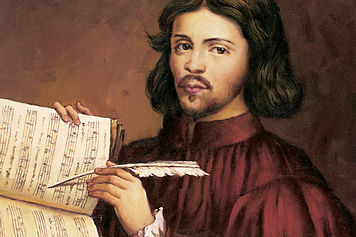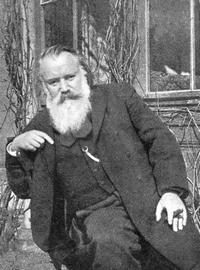The Well-Tempered Ear
Classical music Q&A: Choral director Robert Gehrenbeck talks about how composer Ralph Vaughan Williams sparked TWO renaissances or revivals of British music. You can hear the results when the Wisconsin Chamber Choir performs works by Vaughan Williams and his followers this Saturday night. Part 1 of 2. | May 29, 2014
By Jacob Stockinger
This Saturday night, the Wisconsin Chamber Choir will wrap up its current season with a special concert of “Ralph Vaughan Williams and Friends.”
The concert is at 7:30 p.m. on Saturday, May 31, in the acoustically resonant Grace Episcopal Church, West Washington Avenue at Carroll Street on the Capitol Square, downtown Madison.
The soloists include violinist Leanne League and organist Mark Brampton Smith.
Admission is $15, $10 for students.
One of the best loved choral composers, Ralph Vaughan Williams was renowned not only for his compositions, but also for his friendship and advocacy on behalf of countless other musicians.
The concert features some of Vaughan Williams’ best-known works including, “Serenade to Music,” Mass in G Minor, and the powerful anthem, “Lord, Thou Hast Been Our Refuge.”
Vaughan Williams shared a passion for collecting folksongs with his close friend Gustav Holst, whose heartfelt setting of “I Love My Love” will be heard alongside several of Vaughan Williams’ own folksong arrangements.
Works by Herbert Howells and Vaughan Williams’ students Imogen Holst and Elizabeth Maconchy will demonstrate Vaughan Williams’ influence on succeeding generations.
Finally, selections from the motets and anthems of Thomas Tallis exemplify Vaughan Williams’ debt to his English predecessors, notably Tallis’ “Third Mode Psalm Tune,” the inspiration for Vaughan Williams’ “Fantasia on a Theme by Thomas Tallis.” (You can hear that “Fantasia” performed in a popular YouTube video at the bottom.)
Joining the WCC in this performance are violinist Leanne League, associate concertmaster of both the Madison Symphony and the Wisconsin Chamber Orchestra; and organist Mark Brampton Smith.
Advance tickets are available for $15 from www.wisconsinchamberchoir.org, via Brown Paper Tickets, or at Willy Street Coop (East and West locations) and Orange Tree Imports. Student tickets are $10.
Founded in 1998, the Madison-based Wisconsin Chamber Choir has established a reputation for excellence in the performance of oratorios by Johann Sebastian Bach, Wolfgang Amadeus Mozart, and Franz Joseph Haydn; of a cappella masterworks from various centuries; and of world-premieres. Dr. Robert Gehrenbeck, who teaches and directs choral activities at the University of Wisconsin-Whitewater, is the Wisconsin Chamber Choir’s Artistic Director.
Gehrenbeck recently agreed to an email Q&A about the upcoming concert:
Why did you choose to do a program based on the influence of Ralph Vaughan Williams (below)? How and why was he so influential?
First and foremost, the music of Ralph Vaughan Williams (below) music is extremely rewarding to perform — it’s thrilling for players, singers and audiences alike. He seemed to have a special knack for writing for voices, and he composed an enormous amount of vocal music, from folksong settings, hymn tunes, and solo songs to large-scale operas, oratorios and choral symphonies.
He was the leading figure in the “English Renaissance” of the early 20th century, a movement that began with Sir Edward Elgar and which extended beyond Vaughan Williams to those he influenced, including Gustav Holst, Herbert Howells, and Gerald Finzi (below).
Even Benjamin Britten (below top) and Michael Tippet (below bottom), although they consciously distanced themselves from the style of Vaughan Williams, followed his pioneering embrace of earlier English composers as models, looking back to the luminaries of Tudor and Stuart periods for inspiration just as he did.
tippett
It is as if the musical genius of Thomas Tallis (below top), William Byrd, and Henry Purcell (below bottom) was reawakened after a long slumber in the works of Vaughan Williams and his successors.
How would you describe the individual musical style and historical importance of Ralph Vaughan Williams, especially given the modernist age?
The issue of Vaughan Williams’ relationship to musical modernism is an interesting one. It’s worth noting that Vaughan Williams, Sergei Rachmaninoff, Arnold Schoenberg, and Charles Ives were all born within two years of one another, between 1872 and 1874.
Although their music is vastly different, they all responded to a similar crisis facing composers after the heyday of the Romantic era -– namely, the challenge of writing music that would be original and distinctive while taking into account the fact that most concertgoers still embraced the Romantics.
One might call this the central dilemma of musical modernism: the need to break with the past while also acknowledging it.
Vaughan Williams’ response to this dilemma, while different from Schoenberg’s or Ives’, was nevertheless highly original and unique.
Comparing Vaughan Williams’ development to Schoenberg’s is instructive. Schoenberg (below) famously broke with tonality — an approach that Vaughan Williams vehemently rejected — but Schoenberg saw himself carrying on the tradition of Bach, Mozart, and Brahms, and he wrote in many of the same forms and used similar techniques as his German forebears. For Schoenberg, simply ignoring the music of late Romantics such as Brahms and Wagner was not an option; in the eyes of his German-speaking public, he was their competitor as much as their heir. Schoenberg thus felt compelled to transcend the highly chromatic musical language of Wagner by rejecting its central feature — tonality — while preserving its chromaticism and emotionalism.
By virtue of geography, Vaughan Williams (as well as Rachmaninoff and Ives) did not feel so shackled to the legacy of German Romanticism. For composers on the periphery, as it were, rejecting the dominant German tradition and embracing native influences were virtues in the eyes of their compatriots, especially given the rise of nationalism throughout Europe during this period.
Thus, Vaughan Williams developed a kind of modernism that was infused with elements of his own English heritage. Unlike many of his contemporaries, Vaughan Williams’ music owes very little to Wagner, but he does carry on the symphonic tradition of Ludwig van Beethoven (Vaughan Williams wrote nine symphonies too!); he was a great admirer (and conductor) of Johann Sebastian Bach (below top); and he was strongly influenced by Johannes Brahms (below bottom).
Crucially, Vaughan Williams’ abiding interest in English folksong, in Tudor polyphony, and in writing music that would speak to the common people resulted in a style that was uniquely his — more conservative than other composers’, perhaps, but no less original because of that fact.
Three of the main characteristics of Vaughan Williams’ mature style are the primacy of melody; the retention and enrichment of triadic harmony; and his interest in creating large-scale forms and dramatic tension through non-traditional means. I’ll attempt to illustrate these traits in my answer to the following question.
Tomorrow: Favorite works by Ralph Vaughn Williams; his influence on his contemporaries and his students; and plans by the Wisconsin Chamber Orchestra for the next season.
Tags: Ancora String Quartet, Arnold Schoenberg, Arts, Bach, Beethoven, Chamber choir, Chamber music, Choir, choral music, Classical music, Edward Elgar, Gustav Holst, Imogen Holst, Jacob Stockinger, Johann Sebastian Bach, Johannes Brahms, London, Ludwig van Beethoven, Madison, Madison Symphony Orchestra, mass, Music, Ralph Vaughan Williams, Thomas Tallis, vaughan williams, Wisconsin, Wisconsin Chamber Orchestra, YouTube
2 Comments »












[…] https://welltempered.wordpress.com/2014/05/29/classical-music-qa-choral-director-robert-gehrenbeck-ta… […]
LikeLike
Pingback by Classical music Q&A: Choral director Robert Gehrenbeck talks about his favorite works by British composer Ralph Vaughan Williams. You can hear some of them when the Wisconsin Chamber Choir — which unveils its 2014-15 season here — performs — May 30, 2014 @ 6:52 am
[…] https://welltempered.wordpress.com/2014/05/29/classical-music-qa-choral-director-robert-gehrenbeck-ta… […]
LikeLike
Pingback by Classical music Q&A: Choral director Robert Gehrenbeck talks about his favorite works by British composer Ralph Vaughan Williams. You can hear some of them when the Wisconsin Chamber Choir — which unveils its 2014-15 season here — performs — May 30, 2014 @ 12:01 am